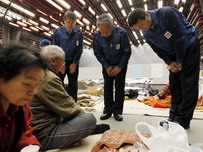 Japan
Japan
The embattled nation, reeling from the triple calamity of a massive earthquake, tsunami and a crippled atomic power plant, was also inviting foreign experts to help stabilize the overheating
The embattled nation, reeling from the triple calamity of a massive earthquake, tsunami and a crippled atomic power plant, was also inviting foreign experts to help stabilize the overheating
 |
|
In a file picture taken on March 23, 2011 Norio Tsuzumi (C-standing), vice president of Tokyo Electric Power Company, and employees bow their heads to apologize to evacuees at a shelter in Fukushima prefecture |
The
And
The strain of the crisis appeared to have taken a toll on TEPCO's president Masataka Shimizu, 66, who was hospitalized Tuesday evening with high blood pressure and dizziness, having not appeared in public for over two weeks.
The company has seen its share price plunge by three-quarters and faced heavy criticism, most recently over news that it ignored expert warnings on the threat of a tsunami before a giant wave crashed into the plant on March 11.
As
"We are in an unprecedented situation, so we need to think about different strategies, beyond what we normally think about," the official told AFP.
Iodine-131 detected in
"The figures are rising further," said nuclear safety agency spokesman Hidehiko Nishiyama. "We need to find out as quickly as possible the cause and stop them from rising any higher."
Radioactive steam has also wafted into the air, contaminating regional farm and dairy produce, and last week led to elevated iodine levels in drinking water in megacity Tokyo, 250 kilometres (155 milles) to the southwest.
Japanese authorities have repeatedly stressed that none of the affected food products or water currently presents an immediate threat to human health, and that ocean currents will dilute radioactivity in the sea.
Among the options
Another plan is to anchor an empty tanker off reactor two, so that workers can pump several Olympic swimming pools worth of highly-radioactive runoff water into its hull, the daily said, citing unnamed government officials.
While the government did not explicitly confirm the report, Chief Cabinet Secretary Yukio Edano said
With crucial control room functions still disabled, experts are not sure what exactly is happening inside the reactors - and some international experts have issued dire warnings that a meltdown may already be in progress.
One of them is Richard Lahey, who was head of safety research for boiling-water reactors at General Electric when it installed the Fukushima units, and who was quoted by Britain's Guardian newspaper.
Available reactor and radiation data from the specially troubled unit two "suggest that the core has melted through the bottom of the pressure vessel" and onto the concrete floor, he was quoted as saying by the daily. "I hope I am wrong, but that is certainly what the evidence is pointing towards."
In
"However, long-term cooling of the reactors and pools is essential during this period and has not been adequately restored to date, to the best of my knowledge. A massive cleanup operation obviously remains for the future."

 Previous page
Previous page Back to top
Back to top







